A Brief Explanation of the Sacrament of Baptism
In the Orthodox Church we follow the Apostolic practice of the early church of “Triple Initiation;” Baptism, Chrismation, and Holy Communion, and also infant baptism.
Baptism is the way we are united to Jesus Christ and His Church - we die to the old life separated from God, (as a result of the fall of Adam and Eve), and are resurrected to a new life in Christ.
Baptism is our Easter experience. From the moment of baptism, we, infants included, become full members or citizens of the Body of Christ able to receive all of God’s grace through the sacraments of the Church.
Chrismation or Confirmation is our Pentecostal experience where we receive the gifts of the Holy Spirit and are confirmed into the Orthodox Faith.
Holy Communion is the spiritual food, the bread of life, which Our Lord gives to us as a gift, when He is “The Gift”. Holy Communion nourishes us in the faith and brings us closer God. By receiving the true Body and Blood of Christ, each time we receive, we are united with the resurrected Human Nature of Christ. Holy Communion, therefore, is the most profound way in which we come into personal contact with our Savior Jesus Christ. The sacrament is for our spiritual and physical health, and it is a means for forgiveness of sins and the hope of eternal life.
It is tradition that the newly initiated person receives Holy Communion for three consecutive Sundays, and after that as frequently as possible.
The role of Godparent(s) in the Orthodox Church is taken very seriously. It reflects a new spiritual relationship between the newly baptized and his/her sponsors. Therefore, the Godparent(s) must be an Orthodox Christian who is a member in good standing, canonically and ecclesiastically with the Church.
When a child or adult is baptized a special name is chosen for the neophyte. It must be either a biblical name or a saint’s name so that the newly baptized can have a role model of the Church to grow with and imitate. The Saints of Orthodoxy are the heroes of the Faith who have “fought the good fight” and have received their spiritual crown in heaven. The Godparent(s) and the parents have the responsibility to serve as Orthodox Christian role models. They assist in the raising and nourishing of the child in the faith.
Baptism is the Sacrament, which cleanses us from the sin of both Ancestral Sin and our personal sins. Jesus said, “Go therefore and make disciples of all nations, baptizing them in the name of the Father and of the Son, and of the Holy Spirit, teaching them to observe all that I have commanded you; and lo, I am with you always, even unto the end of the world” (Matthew 28:19-20).
The practice of Baptism is found in some of the earliest Christian documents. In 217 A.D. Bishop Hippolytus of Rome wrote in his Apostolic Tradition, “They who are to be set apart for baptism shall be chosen after their lives have been examined. . .prayer shall be made over the water. First baptize the little ones; if they can speak for themselves, they shall do so, if not their parents or other relatives shall speak for them. Then baptize the men, and the women.
Visible Symbols in the Sacrament of Baptism
There are many visible symbols that are used in the Sacrament of Holy Baptism in the Orthodox Church. We take elements of the earth created by God and use them in His Holy Mysteries. Those symbols, which we can see, are used to convey God’s abundance grace, which we cannot see. Listed below are those symbols.
THE BAPTISMAL FONT - Has been referred to by the Church Fathers as the Divine Womb from which we receive our second birth as children of God. The Font represents both the Jordan River and the Tomb of Christ. The Newly Baptized is raised or resurrected to a new life in Christ.
WATER - Water is used for cleansing. In baptism it expresses the fact that through this sacrament Christ cleanses us from original and personal sins.
OLIVE OIL - Oil is blessed then applied by the priest to the various members of the child’s body: hands, feet, ears mouth, in order to dedicate them to the service of Christ. Olive oil is used as a symbol of reconciliation, recalling the dove that brought the olive twig in its mouth to Noah.
WHITE CLOTHES AND CANDLES - New white clothes signify the entirely new life that we receive after we are “buried with Jesus in death” (Rom. 6:4). The white clothes express the purity of the soul that has been washed from sin. The Candles are a constant reminder for the Christian to live and die by the light of Christ.
THE TONSURING - As an expression of gratitude to God, after the newly baptized has been Baptized and Confirmed, the priest cuts three locks of hair from the child’s head as a symbol of strength (see Samson in the Old Testament). The child promises to serve God with all his strength and with total dedication.
A CROSS AND CHAIN - The Godparent(s) provide a cross which is blessed by the priest and placed on the child. The Cross is the most important symbol in Christianity. it is also a vessel of protection.
